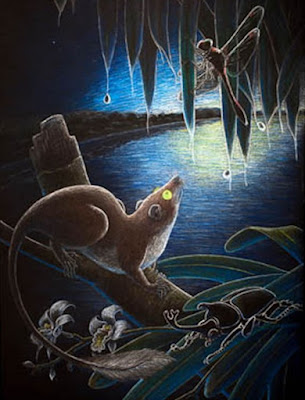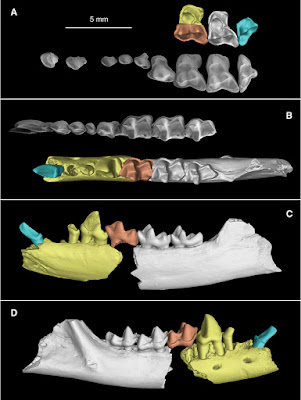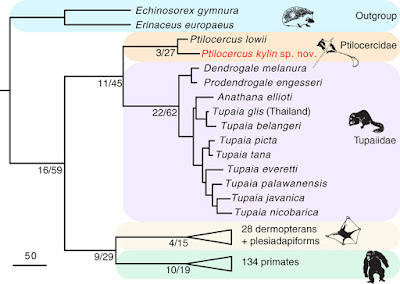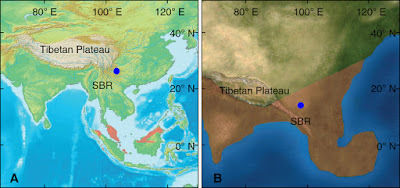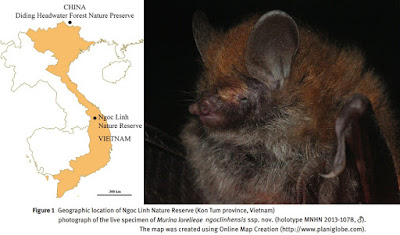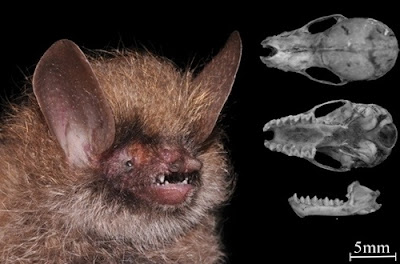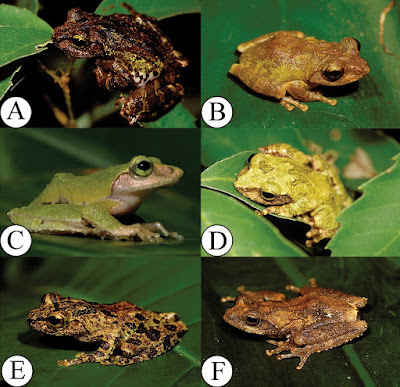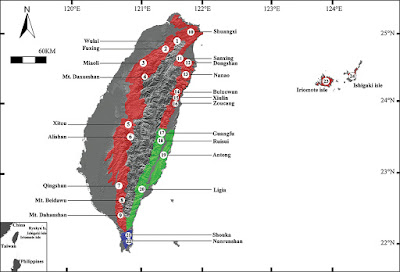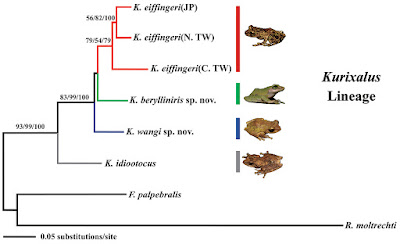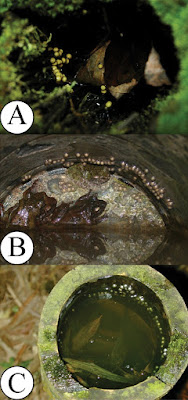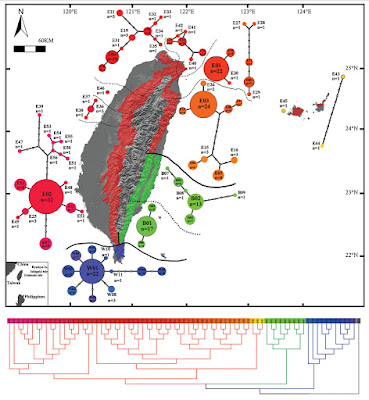[Most Recent Entries] [Calendar View]
Sunday, January 31st, 2016
| Time | Event | ||||||
| 3:05p | [PaleoMammalogy • 2016] Ptilocercus kylin • An Early Oligocene Fossil Demonstrates Treeshrews (Scandentia) are Slowly Evolving “Living Fossils”
Abstract Treeshrews are widely considered a “living model” of an ancestral primate, and have long been called “living fossils”. Actual fossils of treeshrews, however, are extremely rare. We report a new fossil species of Ptilocercus treeshrew recovered from the early Oligocene (~34 Ma) of China that represents the oldest definitive fossil record of the crown group of treeshrews and nearly doubles the temporal length of their fossil record. The fossil species is strikingly similar to the living Ptilocercus lowii, a species generally recognized as the most plesiomorphic extant treeshrew. It demonstrates that Ptilocercus treeshrews have undergone little evolutionary change in their morphology since the early Oligocene. Morphological comparisons and phylogenetic analysis support the long-standing idea that Ptilocercus treeshrews are morphologically conservative and have probably retained many characters present in the common stock that gave rise to archontans, which include primates, flying lemurs, plesiadapiforms and treeshrews. This discovery provides an exceptional example of slow morphological evolution in a mammalian group over a period of 34 million years. The persistent and stable tropical environment in Southeast Asia through the Cenozoic likely played a critical role in the survival of such a morphologically conservative lineage. Ptilocercus kylin sp. nov. Etymology: Specific epithet is derived from the name of Qilin District, in Qujing City. Qilin is the pinyin for kylin, a hoofed dragon-like beast of Chinese myth. Holotype: IVPP V20696 (Fig. 1), a right mandibular fragment preserving m2 and m3. Locality and horizon: Lijiawa Mammalian Fossil locality, Yunnan Province, China. Earliest Oligocene, ~ 34 Ma.
Qiang Li and Xijun Ni. 2016. An Early Oligocene Fossil Demonstrates Treeshrews are Slowly Evolving “Living Fossils”. Scientific Reports. 6; 18627. DOI: 10.1038/srep18627 Earliest-known treeshrew fossil found in Yunnan, China http://phy.so/373022526 via @physorg_com | ||||||
| 4:24p | [Mammalogy • 2015] Murina lorelieae ngoclinhensis • First Records of Murina lorelieae (Chiroptera: Vespertilionidae) from Vietnam
Abstract In 2011, three specimens from an unknown species of tube-nosed bat (genus Murina) were collected in montane moist forest at altitudes between 1117 and 1682 m in the Ngoc Linh Nature Reserve of Vietnam. We sequenced the mitochondrial COI gene from Ngoc Linh bats and performed comparisons with Murina sequences available in the nucleotide databases. The results suggested that the three unidentified specimens belong to Murina lorelieae, a species recently described from a single specimen collected in southern China. Nucleotide distances between specimens from Ngoc Linh and southern China are exceptionally low for M. lorelieae (1.25%) in comparison with three other Murina species, i.e., Murina cyclotis, Murina feae, and Murina huttoni (3.9–5.5%). We suggest that M. lorelieae is adapted to montane forests, which may have facilitated long-distance dispersal events between southern China and Vietnam during glacial periods of the Pleistocene. Morphological comparisons based on body-size measurements and geometric morphometric analyses of the skulls showed differences between Vietnamese specimens and the Chinese holotype of M. lorelieae. We proposed that the Vietnamese specimens belong to a distinct subspecies, Murina lorelieae ngoclinhensis. Keywords: DNA barcode; morphology; Murininae; Southeast Asia; subspecies Vuong Tan Tu, Raphaël Cornette, Jose Utge and Alexandre Hassanin. 2015. First Records of Murina lorelieae (Chiroptera: Vespertilionidae) from Vietnam. MAMMALIA. 79(2); 201–213 DOI: 10.1515/mammalia-2013-0101 Researchgate.net/publication/274575482_F | ||||||
| 4:33p | [Mammalogy • 2015] Murina kontumensis • A New Species of the Genus Murina (Chiroptera: Vespertilionidae) from the Central Highlands of Vietnam with A Review of the Subfamily Murininae in Vietnam
The subfamily Murininae has high species diversity in Vietnam, but taxonomic studies are limited. In this paper, we describe a new species of the genus Murina based on a specimen collected from Ngoc Linh Nature Reserve, Kon Tum Province in the Central Highlands of Vietnam. It is a medium-sized species with ‘suilla-type’ dentition. A taxonomic review of Murininae from Vietnam was also conducted based on combined morphological, DNA, and karyological characteristics. Molecular phylogenetic analyses based on the mitochondrial cytochrome coxidase subunit (COI) gene supported the subfamily Murininae, while the genus Murina proved to be paraphyletic in relation to the genera Harpiocephalus and Harpiola. Fourteen species of the genus Murina, one species of Harpiocephalus, and one species of Harpiola are recognized from Vietnam. Murina tiensa is regarded as a junior synonym of M. harrisoni; strong sexual dimorphism was observed in M. harrisoni. Relations between forearm length and total length of skullshowed different trends among species and sexes. Karyotypes of Murina huttoni, M. cyclotis, M. lorelieae, M. beelzebub, M. feae, and Harpiola isodon were 2n = 44, FN = 50, while that of Harpiocephalus harpia was 2n = 44, FN = 52. Key words: DNA barcode, karyotype, morphology, taxonomy, tube-nosed bats Nguyen Truong Son, Gabor Csorba, Vuong Tan Tu, Vu Dinh Thong, Wu, Y., Harada, M., Oshida, T., Endo, H. and Motokawa, M. 2015. A New Species of the Genus Murina (Chiroptera: Vespertilionidae) from the Central Highlands of Vietnam with A Review of the Subfamily Murininae in Vietnam. ACTA CHIROPTEROLOGICA. 17(2); 201-232. DOI: 10.3161/15081109ACC2015.17.2.001 Phát hiện loài dơi mới ở Kon Tum - VnExpress http://bit.ly/1VfjlIb New bat species found in Central Highlands - http://english.vietnamnet.vn/fms/science-i | ||||||
| 4:45p | [Herpetology • 2016] Systematic Revision of the Taiwanese Genus Kurixalus members (Anura, Rhacophoridae) with A Description of Two New Endemic Species; Kurixalus berylliniris & K. wangi Abstract Two new species of rhacophorid tree frog were identified in Taiwan. In both new taxa, derived reproductive characteristics of laying eggs in tree holes and oophagous tadpoles are shared with Kurixalus eiffingeri, but they are divergent from each other in molecular genetics, mating calls, and tadpole and adult morphology. The morphological characteristics and the molecular phylogenetic evidence support the hypothesis that the two new species, Kurixalus berylliniris sp. n. and Kurixalus wangi sp. n., are both monophyletic lineages. Keywords: Kurixalus berylliniris sp. n., Kurixalus wangi sp. n., oophagous tadpoles Systematics Kurixalus berylliniris sp. n. Type locality: Ligia timber trail, 1250 meters above sea level, Taitung County, Taiwan, Republic of China (Fig. 1, Loc. 20, 22°49'26.79"N, 121°00'35.45"E). Diagnosis: A moderate-sized Kurixalus. Females average about 41 mm snout-vent length (range: 27.6–46.3 mm); males average about 35 mm (range: 29.0–42.3 mm). Iris emerald to light green. Two dark brown spots on eyelids, separated from each other and from X-shaped blotch on dorsum. Subarticular tubercles on foot rounded and flat. Belly and throat white or faintly-speckled. Prepollex in males squarish, compressed and expanded. About half-webbed between two outer toes. Anterior margin of tadpole dorsal fin extending to body. Tadpole heavily dark brown to black pigmented in gular region and on tail muscle. Upper lip of tadpole with deep transverse furrow, and prominent ridge extending from upper lip to anterior margin of nostril (key of tadpole, 3). Etymology: The epithet berylliniris is a compound word formed from beryllin (L.), green-colored, and from iris (L.), iris of the eye, and is treated as a noun in nominative singular in opposition to the generic name. Distribution and ecological notes: Kurixalus berylliniris sp. n. occurs in eastern Taiwan (at 225 to 1250 meters above sea level). The highest recorded elevation was on the eastern slope of the Central Mountain Range (Taitung County, 1250 meters above sea level), and the lowest recorded elevation was on the western slope of the Coastal Range (Hwalien County, 225 meters above sea level). Specimens were collected near the canopy level in moist broad-leaf forests in Taitung and on forest edges in Hwalien. The northern border of the specimen’s distribution was near the Guangfu township of the central Hualien County (Fig. 1, Green stain). Kurixalus wangi sp. n. Type locality: Shouka timber trail, 400 meters above sea level, Pingtung County, Taiwan, Republic of China (Fig. 1, Loc. 21, 22°13'15.58"N, 120°49'21.92"E). Diagnosis: A small to moderate-sized Kurixalus. Females snout-vent length averaging about 34 mm (range: 30.8–37.1 mm); males averaging 30 mm (range: 28.6–31.6 mm). Iris golden-yellow. Two anterior horns of the X-shaped marking on back extending to eyelid. Webbing extensive on toes, extending to the toe disc on the inner margin of toe V. Belly and throat whitish. Anterior margin of tadpole dorsal fin extending to posterior body. Tadpole with almost no pigment on region of tail muscle. Upper lip of tadpole with shallow transverse furrow. Etymology: The epithet is named and dedicated to Mr. Ching-Shong Wang for his pioneering work and contributions to the herpetology of Taiwan (Wang 1962). Mr. Wang discovered two rhacophorid frogs (Rhacophorus taipeianus and K. idiootocus) (Liang and Wang 1963, Kuramoto and Wang 1987) in Taiwan and suggested, in the early 1980s, that some Kurixalus specimens collected near the type locality of this new species might be different from K. eiffingeri (personal communication). The name is used in the genitive case. Distribution and ecological notes: Kurixalus wangi sp. n. is distributed in the southern part of Pingtung County in southern Taiwan below 500 meters above sea level (Fig. 1, Blue dots). All specimens were collected in the shrubs of secondary forests or lowland broad-leaved forests at low altitudes. Phylogenetic relationships As demonstrated by the high bootstrap support, the robustness of the phylogenetic relationship of the three rhacophorid genera is strong. Based on this robust phylogenetic tree, we found that the among-genera genetic distances were greater than the within-genus genetic distance (Fig. 10). Using the partial sequence of mtDNA CO1 gene as a molecular marker (Table S2), the genetic distances of the all pair-wise comparisons of the four Kurixalus species were all larger than 10% (Table S3). The phylogenetic trees constructed by Bayesian inference, NJ analysis, and MP methods showed the same topology (Fig. 10). The topology of branches was sufficiently supported by the posterior probabilities, bootstrap values, and branch lengths. The four Kurixalus species of Taiwan formed a well-structured monophyletic group with distinguishable branch length. Samples of K. eiffingeri collected from Iriomote Island, northern Taiwan, and central Taiwan were embedded in the same lineage and formed a monophyletic group (Fig. 11 below). Individuals from southern (Kurixalus wangi sp. n.) and eastern Taiwan (K. berylliniris sp. n.) were sister taxa of K. eiffingeri. Kurixalus idiootocus was phylogenetically distinct from the three Kurixalus species (Figs 10 and 11 below). Shu-Ping Wu, Chuan-Chin Huang, Chi-Li Tsai, Te-En Lin, Jhih-Jia Jhang and Sheng-Hai Wu. 2016. Systematic Revision of the Taiwanese Genus Kurixalus members with A Description of Two New Endemic Species (Anura, Rhacophoridae). ZooKeys. 557: 121-153. DOI: 10.3897/zookeys.557.6131 |
| << Previous Day |
2016/01/31 [Calendar] |
Next Day >> |

